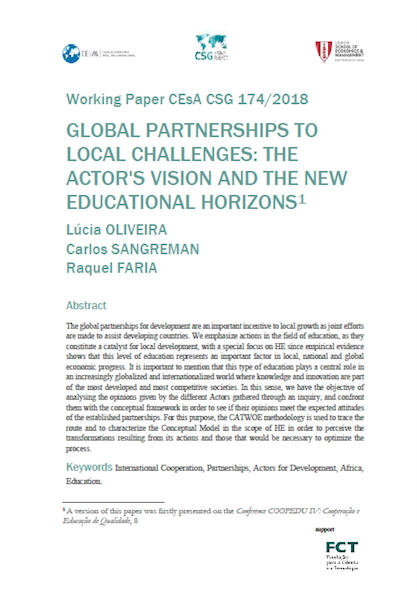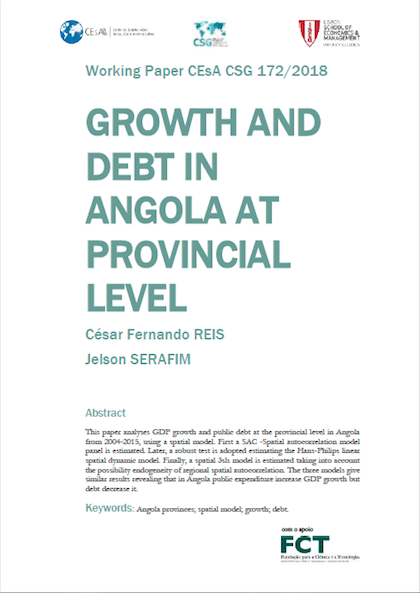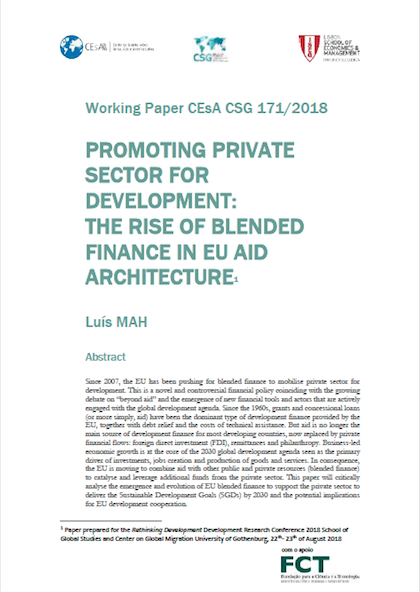Developing Countries

Working Paper 174/2018: Global Partnerships to Local Challenges: The actor’s vision and the new educational horizons
Abstract:
The global partnerships for development are an important incentive to local growth as joint efforts are made to assist developing countries. In Global Partnerships to Local Challenges: The actor’s vision and the new educational horizons we emphasize actions in the field of education, as they constitute a catalyst for local development, with a special focus on HE since empirical evidence shows that this level of education represents an important factor in local, national and global economic progress. It is important to mention that this type of education plays a central role in an increasingly globalized and internationalized world where knowledge and innovation are part of the most developed and most competitive societies. In this sense, we have the objective of analysing the opinions given by the different Actors gathered through an inquiry, and confront them with the conceptual framework in order to see if their opinions meet the expected attitudes of the established partnerships. For this purpose, the CATWOE methodology is used to trace the route and to characterize the Conceptual Model in the scope of HE in order to perceive the transformations resulting from its actions and those that would be necessary to optimize the process.
Quotation:
Oliveira, Lúcia, Carlos Sangreman e Raquel Faria (2018). “Global partnerships to local challenges: the actor’s vision and the new educational horizons”. Instituto Superior de Economia e Gestão – CEsA/ CSG Documentos de Trabalho nº 174/2018.

Working Paper 172/2018: Growth and Debt in Angola at Provincial Level
Abstract:
The relationship between growth and debt has attracted some research in past,(Eberhardt and Presbitero, 2015, Panizza and Presbitero, 2014, Kourtellos et al., 2013; Checherita-Westphal and Rother, 2012). This hypothesis has been tested for development countries and evidence from Africa countries restricted (Mistry, 1991; Ussain and Gunter, 2005; Mohamed, 2013; Owusu-Nantwi and Erickson, 2016). Reinhart and Rogoff (2010) find that growth rates fall in advanced and emerging market economies when the public debt-to-GDP ratio exceeds 90 percent and that high debt levels are correlated with higher inflation only in emerging markets. The Weak Government Hypothesis states that government fragmentation leads to higher public deficits and debt. This relation can be explained by government inaction, common pool problems or the strategic use of debt that arise in coalition governments (Ashworth, Geys and Heyndels, 2005). Therefore, this paper analyzes the relationship between debt and growth in Angola provinces from 2004-2015, using a spatial model. The spatial model is adequate in the present context as the focus are at regional level (Zhao, Tong and Qiao, 2002; chakravorty, 2003; Haddad, 2008; Barros, Faria and Araujo Jr., 2014) The SAC- Spatial autocorrelation model is adequate when the spatial autocorrelation is intense as it is in Angola context. The motivation for Growth and debt in Angola at provincial level is the following, first, growth at regional level is usually lower than at national level, revealing heterogeneity among Angola provinces that justifies the investigation between growth and debt. Second, regional public expenditure is taken into account since it is a component of the growth and debt. Third, regional public debt is not published in Angola and the access to it needs a ministry of finance accordance. This restricted access signifies that it is a political issue and therefore it may hide some political issues. Therefore, the use of it in and growth debt paper is curious. Additional, the Angola regional provinces are managed by MPLA- Movimento popular de Libertação de Angola members, the incumbent government, signifying that there is a centrality of power that increases the regional spatial correlation. This paper analyses GDP growth and public debt at the provincial level in Angola from 2004-2015, using a spatial model. First a SAC -Spatial autocorrelation model panel is estimated. Later, a robust test is adopted estimating the Hans-Philips linear spatial dynamic model. Finally, a spatial 3sls model is estimated taking into account the possibility endogeneity of regional spatial autocorrelation. The three models give similar results revealing that in Angola public expenditure increase GDP growth but debt decrease it.
Quotation:
Reis, César Fernando e Jelson Serafim (2018). “Growth and debt in Angola at provincial level”. Instituto Superior de Economia e Gestão – CEsA/ CSG –Documentos de Trabalho nº 172/2018.

Working Paper 171/2018: Promoting Private Sector for Development: The rise of blended finance in EU aid architecture
Abstract:
Since 2007, the EU has been pushing for blended finance to mobilise private sector for development. This is a novel and controversial financial policy coinciding with the growing debate on “beyond aid” and the emergence of new financial tools and actors that are actively engaged with the global development agenda. Since the 1960s, grants and concessional loans (or more simply, aid) have been the dominant type of development finance provided by the EU, together with debt relief and the costs of technical assistance. But aid is no longer the main source of development finance for most developing countries, now replaced by private financial flows: foreign direct investment (FDI), remittances and philanthropy. Business-led economic growth is at the core of the 2030 global development agenda seen as the primary driver of investments, jobs creation and production of goods and services. In consequence, the EU is moving to combine aid with other public and private resources (blended finance) to catalyse and leverage additional funds from the private sector. Promoting private sector for development: the rise of blended finance in EU aid architecture will critically analyse the emergence and evolution of EU blended finance to support the private sector to deliver the Sustainable Development Goals (SGDs) by 2030 and the potential implications for EU development cooperation.
Quotation:
Mah, Luís (2018). “Promoting private sector for development : the rise of blended finance in EU aid architecture”. Instituto Superior de Economia e Gestão – CEsA /CSG – Documentos de Trabalho nº 171/2018.





